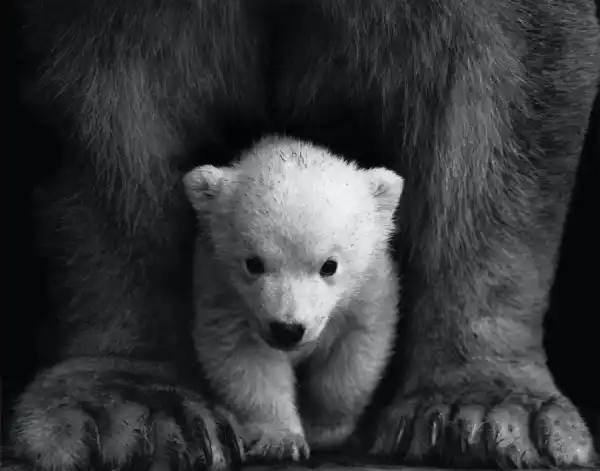Polar bears are a large species of bear native to the Arctic Circle and adjacent land masses. Known for their thick white fur, they are the world’s largest land carnivore, with large males measuring over 8 feet tall and weighing up to 1,400 pounds.
These majestic creatures are an icon of the Arctic and have become increasingly threatened due to climate change and human-induced disturbances.
Although polar bears are typically associated with the icy regions of the north, they can be found in other parts of the world as well, such as Russia, Norway, Greenland, Canada, and the United States.
In this blog post, we will provide a brief overview of polar bears, including their size, weight, and general ecology.
We will also discuss the current threats facing polar bears in the wild, as well as how we can help protect them.
Size of polar bears
Average length and height of adult polar bears
The average length and height of an adult polar bear is generally 8 to 9 feet long, with an average shoulder height of 4 to 5 feet and an average weight of 350 to 1,150 lbs.
These figures can vary depending on the individual and their habitat, with those living in warmer climates tending to be smaller in size than those living in colder climates.
Polar bears are the largest land carnivores in the world and can weigh up to 2,000 lbs, though this is very rare.
They are also the largest bear species, with the smallest being the sun bear. Polar bears are an important part of the Arctic ecosystem and play a vital role in the balance of their environment.
female polar bear weight
Female polar bears typically weigh between 330 and 550 kg, with an average weight of around 400 kg.
Female polar bears reach their adult weight at around five years of age. At this point, they typically weigh about 200 kg. Female polar bears reach their peak body mass at around the age of 10, when they can weigh up to 550 kg.
Polar bears are the largest land carnivores on Earth and the largest of the bear species. Polar bears can weigh up to 1,000 kg and stand up to 3 meters tall when on their hind legs.
Female polar bears require a large amount of food to maintain their body weight and must hunt for their food in the Arctic environment. With their thick fur and blubber and their large body mass, female polar bears are equipped to withstand the cold and challenging Arctic climate.
Baby polar bear weight

Baby polar bears typically weigh around 1.5 to 3.5 pounds at birth. As they grow, they can reach up to 200 to 600 pounds as adults.
Polar bears have a very slow growth rate, taking up to three years for them to reach half of their adult weight. During this growth period, polar bear cubs remain with their mother for two to three years, and during this time, the mother bear provides her cubs with food and protection.
The mother bear will also teach her cubs how to hunt and survive in the hostile Arctic environment. Polar bear cubs will gradually increase their weight as they grow, and they will eventually reach their adult weight within three to five years.
Comparison to other bear species
They are an iconic species of bear that are readily identified by their white fur and striking blue eyes. They are the only bear species that are considered marine mammals due to their semi-aquatic lifestyle and diet.
Polar bears are the largest bear species and have the thickest fur, which helps to keep them warm in their cold Arctic environment.
In comparison to other bear species, polar bears have a wider and more rounded head, shorter muzzle, and longer neck. They are also the only bear species that have webbed feet and partially retractable claws, which help them navigate icy terrain.
Polar bears are known to roam over vast distances in search of food and can swim for days at a time, hunting for seals.
Overall, the polar bear is an impressive species of bear that is uniquely adapted to its harsh environment.
Variation in size among different populations
Polar bears vary in size among different populations. This can be attributed to factors such as diet, environment, and genetics. Polar bears in the Arctic tend to be the largest, while those in the subarctic are typically smaller.
These variations in size have a direct influence on their overall health and well-being. For example, smaller polar bears have been observed to have lower body fat levels and higher mortality rates.
Larger polar bears carry more fat reserves, allowing them to survive longer periods of fasting.
Size variation between populations has a direct effect on their ability to survive in their environment. Understanding these variations is crucial for conservation efforts to ensure that these majestic creatures thrive in their habitats for generations to come.
Factors that affect a polar bear’s weight
Polar bears rely heavily on their body weight to survive in the arctic environment, and as such, there are several factors that can affect it.
Temperature is a major factor, as bears will gain weight during warmer months when they have access to more food and lose weight during colder months when food is scarce.
Their age also affects their weight, as older bears will naturally weigh less than younger bears. Additionally, the availability of prey and the nutritional content of their diet play a role in their weight.
Their health, levels of physical activity, and reproductive cycle all have an impact on their overall weight.
Understanding these factors is important in order to ensure the polar bear population is maintained and healthy.
Polar bear diet and weight

What do polar bears eat and how does it affect their weight?
They typically hunt seals from the edges of ice floes, waiting for the seal to surface from beneath the ice. In addition to seals, polar bears will also hunt small land mammals, such as lemmings, as well as scavenge for carrion.
Polar bears are capable of eating large amounts of food in a single sitting, and in some cases, it is not uncommon for a polar bear to consume over 30 kilograms of food in a single meal. This high-calorie diet is essential for polar bears as it helps them to maintain their large body sizes and thick layers of insulating fur.
As an adaptation to the cold climate, polar bears have evolved to store large amounts of fat, which is why they are among the heaviest of bear species.
How do polar bears hunt and how does it affect their weight?
Polar bears are highly specialized hunters, utilizing their keen sense of smell and ability to swim to great depths to track and capture their prey.
They mainly prey on seals, which they can detect from up to 20 miles away, and they are capable of swimming underwater as deep as 10 feet. This hunting behavior is one of the reasons why polar bears can reach such massive sizes, with adult males usually weighing between 770 and 1,500 pounds.
However, if their prey is scarce during certain seasons, polar bears will have to resort to eating other food sources, such as vegetation, and this can cause them to lose a lot of weight.
Climate change is also affecting polar bear hunting habits, as their sea ice habitat is melting, which is making it harder for them to find food and resulting in reduced body size.
Importance of understanding the size and weight of polar bears in conservation efforts
Understanding their size and weight can help us to better understand their habitat needs and their nutritional needs.
It helps to understand the impact of climate change on polar bears, as well as their ability to survive in a rapidly changing environment.
It can also help us to monitor the health of polar bear populations, and to properly manage their habitat. This is especially important since polar bear populations are already under threat due to climate change, overfishing and hunting.
Accurate estimates of their size and weight can help us to make better informed decisions about their conservation and how best to ensure their long-term survival.
Conclusion
Polar bears primarily subsist on a diet of seals, but they will also eat fish and other marine life. Polar bears live in the Arctic region and are able to survive in extremely cold temperatures. They use their thick fur to keep warm and hunt for prey on the sea ice. Their diet is supplemented by scavenging on carcasses such as those of whales.
They are well adapted to their environment, with an impressive ability to swim for long distances and their diet providing them with the necessary sustenance to survive in the Arctic.

